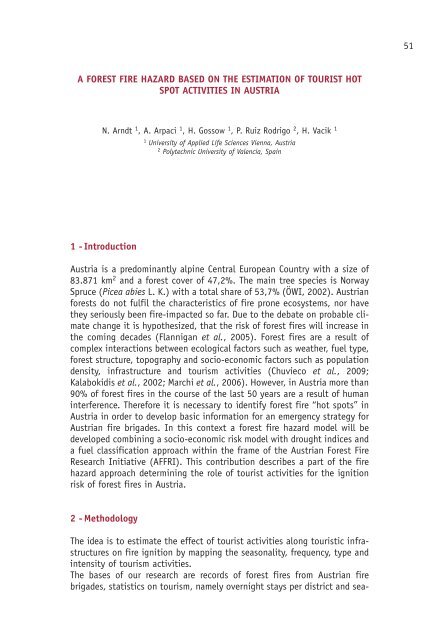7th Workshop on Forest Fire Management - EARSeL, European ...
7th Workshop on Forest Fire Management - EARSeL, European ...
7th Workshop on Forest Fire Management - EARSeL, European ...
You also want an ePaper? Increase the reach of your titles
YUMPU automatically turns print PDFs into web optimized ePapers that Google loves.
A FOREST FIRE HAZARD BASED ON THE ESTIMATION OF TOURIST HOT<br />
SPOT ACTIVITIES IN AUSTRIA<br />
N. Arndt 1 , A. Arpaci 1 , H. Gossow 1 , P. Ruiz Rodrigo 2 , H. Vacik 1<br />
1 University of Applied Life Sciences Vienna, Austria<br />
2 Polytechnic University of Valencia, Spain<br />
1 - Introducti<strong>on</strong><br />
Austria is a predominantly alpine Central <strong>European</strong> Country with a size of<br />
83.871 km 2 and a forest cover of 47,2%. The main tree species is Norway<br />
Spruce (Picea abies L. K.) with a total share of 53,7% (ÖWI, 2002). Austrian<br />
forests do not fulfil the characteristics of fire pr<strong>on</strong>e ecosystems, nor have<br />
they seriously been fire-impacted so far. Due to the debate <strong>on</strong> probable climate<br />
change it is hypothesized, that the risk of forest fires will increase in<br />
the coming decades (Flannigan et al., 2005). <strong>Forest</strong> fires are a result of<br />
complex interacti<strong>on</strong>s between ecological factors such as weather, fuel type,<br />
forest structure, topography and socio-ec<strong>on</strong>omic factors such as populati<strong>on</strong><br />
density, infrastructure and tourism activities (Chuvieco et al., 2009;<br />
Kalabokidis et al., 2002; Marchi et al., 2006). However, in Austria more than<br />
90% of forest fires in the course of the last 50 years are a result of human<br />
interference. Therefore it is necessary to identify forest fire “hot spots” in<br />
Austria in order to develop basic informati<strong>on</strong> for an emergency strategy for<br />
Austrian fire brigades. In this c<strong>on</strong>text a forest fire hazard model will be<br />
developed combining a socio-ec<strong>on</strong>omic risk model with drought indices and<br />
a fuel classificati<strong>on</strong> approach within the frame of the Austrian <strong>Forest</strong> <strong>Fire</strong><br />
Research Initiative (AFFRI). This c<strong>on</strong>tributi<strong>on</strong> describes a part of the fire<br />
hazard approach determining the role of tourist activities for the igniti<strong>on</strong><br />
risk of forest fires in Austria.<br />
2 - Methodology<br />
The idea is to estimate the effect of tourist activities al<strong>on</strong>g touristic infrastructures<br />
<strong>on</strong> fire igniti<strong>on</strong> by mapping the seas<strong>on</strong>ality, frequency, type and<br />
intensity of tourism activities.<br />
The bases of our research are records of forest fires from Austrian fire<br />
brigades, statistics <strong>on</strong> tourism, namely overnight stays per district and sea-<br />
51
















